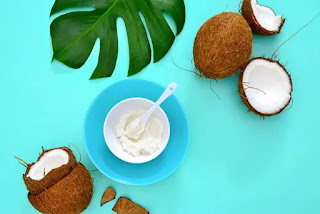History of Coconut Plantation in Indonesia and Its Benefits
 |
| coconut tree |
According to Warisno (1998) The coconut tree and its fruit have a long history in Indonesia, even as a symbol or identifier for the Indonesian archipelago. In Hindu mythology and according to the Vedic Scriptures, the coconut is a "heavenly tree." It is said that Lord Vishnu brought coconut trees as a source of health, tranquility, long life, and peace. The coconut tree is considered sacred, and plays an important role in all religious ceremonies. In everyday life, almost all parts of the coconut plant can be used for various purposes. One of the products from coconut is water, it turns out that in the solution, this coconut fruit water has extraordinary properties and nutritional value. Not only macro elements in the form of nitrogen and carbon, but also micro elements that are needed by the body are in coconut water. The nitrogen element in it is a protein composed of amino acids, such as alanine, cysteine, arginine, alanine, and serine.
Compared to the amino acids found in cow's milk, amino acids are contained in coconut water is actually higher. While the element carbon can be found in the form of simple carbohydrates such as glucose, sucrose, fructose, sorbitol, inositol, and others. Likewise with the micro elements in coconut water in the form of minerals needed as a substitute for body ions. It is feasible, if after drinking young coconut, one's body will feel refreshed.
If investigated further, coconut water also contains a variety vitamin. Among them are the dominant vitamin C, nicotinic acid, folic acid, pantothenic acid, biotin, and riboflavin. No wonder coconut water is also used as an ingredient in traditional medicine as well as for beauty. Besides that, in particular, coconut water is rich in potassium (potassium). Apart from minerals, coconut water also contains sugar (varies between 1.7 to 2.6 percent) and protein (0.07 to 0.55. percent). With this nutritional composition, coconut water has the potential to be used as a raw material for food products.In the Philippines, coconut water is used for the process of making drinks, jelly, alcohol, dextran, vinegar, and nata de coco. In Indonesia, coconut water is used as a drink (young coconut water) and a medium for making nata de coco.
The coconut plant is thought to have originated in South America. Plant coconut has been cultivated around the Andes Valley in Colombia, America South since thousands of years BC. Other records state that the coconut plant originated from the South Asia region or Malaysia, or perhaps the West Pacific. Furthermore, coconut plants spread from one coast to another. The method of spreading coconuts can be through rivers or oceans, or carried by boat crews that are anchored from one coast to another.
The oldest method of cultivating coconut is found in the Philippines and Sri Lanka. In this area, coconut plants have been known since 3000 years ago. There are some experts who argue that the coconut plant originates from the Philippines. The Philippines is also one of the pioneers in processing technology for various coconut products.
Benefits of Coconut In
Indonesia is often called an agricultural country, an archipelago that is rich in abundant natural products. In Indonesia, we often encounter several types of coconut trees. Coconut tree is famous for its benefits because from the tip of the root to the leaves can be used. Anonymous (2015) states that the benefits of coconut plants are as follows.
A. Roots
The benefits of coconut trees from root to shoot are inevitable, coconut roots are very beneficial for the environment. Coconuts have roots that resemble hair, and have a fibrous root system. Coconut roots consist of thousands of thin roots that grow out of the soil surface and only a few of these roots penetrate deep into the soil. Coconut tree produces roots from the base of the trunk throughout its life continuously and the number of roots produced depends on the age of the tree and the environment. Coconut roots usually have less than 3 inches in diameter. Coconut root is generally used in various fields, including.
1. Beverages and herbal medicines.
The roots of the coconut tree can be used as a dye, a base for making toothbrushes, and a base for mouthwash. In addition, by consuming coconut root boiled water that has been filtered, it can help treat various kinds of digestive disorders such as diarrhea, dysentery, and other digestive problems. It can also treat hives.
2. Building construction.
Because it has a strong enough structure, the roots of coconut trees can also be used as building supports (chicken claws).
3. Antidote to flood.
Because it is able to absorb very large amounts of water
many, coconut roots are also believed to be able to prevent flooding. This may be the reason why coconut trees are planted in many residential areas.
4. Various handicraft materials.
Since ancient times, the roots of coconut plants are also often used as an economical handicraft material, such as making bracelets, necklaces and others.
B. Trunk
The trunk of the coconut tree has fibrous grains. There are three basic colors associated with the density of the wood, namely dark brown, medium brown, and luminous gold. Coconut trunks generally have a height of up to 25 meters with a diameter of around 300 mm. The silica content in the stem gives the tree's elasticity effect. Coconut stems have many applications, including the following.
1. As a material for structural and interior design. The use of coconut stems for interior design is divided according to the quality of its density, namely:
a. Coconut stalks are high-density, suitable for general structures such as pillars, trusses, rafting, furniture, windows, door frames, flooring, decking and floor beams.
b. Medium density coconut trunks can be used for walls, ceilings, beams, and horizontal studs.
c. Low density coconut trunks are used in non-load bearing applications such as wood panels, internal trim and ceilings, and household appliances.
2. As an exterior design material. Coconut stalks can also be used for exterior building applications, such as entrances or gates, screens, and doors.
3. The basic material for making paper. Coconut stalks can also be extracted for making paper pulp.
C. Leaves
Coconut has a leaf part which is a single leaf and pinnate.
Various uses of coconut leaves include the following.
1. Coconut leaves that are still young or commonly referred to as leaf, can
used for various things, such as woven material for
decoration of a traditional ceremony, as food wrappers, such as ketupat, and lemet.
2. Old coconut leaves can be used as a woven material for roofs and walls of buildings.
3. Dry coconut leaves can also be used as an ingredient
woven for the manufacture of mats, hats, bags, and various other types of handicrafts. In addition, dried coconut leaves can also be used as a base for making paper after extracting it into pulp.
4. Leaf stems or so-called sticks, can also be used as materials for making cleaning tools, such as garden brooms.
5. And maybe what we don't know yet, it turns out that coconut leaves can also
used as an alternative to animal feed. Coconut leaves constitute
favorite food for elephants.
D. Fruit
Coconut has a fruit that is quite large and round in shape. The diameter of the coconut fruit can reach 10 to 20 cm, or even more. This fruit has a variety of different colors, such as green, yellow, and brown. Coconut fruit is rich in vitamins, minerals and powerful antioxidants. This fruit is composed of three elements, namely
(1) Mesoka Rp in the form of fiber or can be called coir whose job is to protect the inside.
(2) Endoka Rp which is the hard part or so-called
as a shell or shell. It has watertight properties. Endoka Rp serves to protect the seeds.
(3) Endosperm, which is a liquid which contains lots of enzymes. As we get older, this will experience a solid phase which will later settle on the walls of endoka Rp. Each part of the coconut fruit also has various benefits such as.
1. Coconut water
The water in young coconut fruit can be beneficial for
our health. It can provide proper hydration to the body, natural cleansing of the kidneys, and balance electrolytes in the body. In addition, coconut water is also believed to be able to heal burns, get rid of acne and scars, clean amniotic fluid, prevent gray hair and prevent dehydration. In several countries, such as India, Thailand, and Sri Lanka, coconut water is used as a mixture for making soups. In the world of beauty, coconut water is also an ideal ingredient to add to homemade face masks.
2. Coconut flesh
a. The young meat can be consumed directly or used as a mixture in various types of drinks, such as fruit ice. Meanwhile, aged meat is used as coconut milk in various types of food preparations.
b. Coconut meat can also be used as a base for making coconut oil. Coconut oil has a unique, interesting taste. It can be used as a substitute for butter in many recipes.
c. Coconut oil is higher in saturated fat compared to oils like Olive Oil or Canola.
Lauric acid in coconut oil is believed to be very good for health, it can boost immunity and can protect it from various diseases.
d. Apart from that, coconut oil is a great conditioner for hair as well. The use of coconut oil on hair can make dry hair softer and smoother.
e. Coconut oil is also used to massage babies. This is believed to be healthy for the baby's skin.
3. Coconut shell or shell
a. Charcoal for cooking
b. Craft materials such as carvings, rice spoons, scoops, and others
c. Coconut shells can also be processed as cigarette filters
d. Absorbers of harmful gases
e. Purifies fermented CO2
4. Coconut fibers
a. As a scrubber which can be used as a natural cleanser for
clean dinner plates, cups and even floors.
b. Coconut coir is also used as a handicraft material, such as for making doll hair, upholstery, pillows, mats, ropes and carpet industry materials.
c. As a liquid organic fertilizer. The trick is to soak the coconut husks in water for about 15 days or until the soaking water turns black. The content of potassium chloride in the soaking water can be used as a liquid organic fertilizer.
d. Coconut coir can be used as an organic planting medium, by finely grinding it into powder.
E. Interest
Coconut flowers begin to bloom when the coconut is about 4 to 6 years old. The flowers are yellow in color and smell sweet. The flower part is arranged compound in a series that is protected by bractea. Where there are male flowers which are located far from the base and the female which is located at the base of the bouquet. The flower part of coconut can be used as:
a. The fermentation product of coconut flower sap can be used as an ingredient in alcohol and vinegar.
b. As an ingredient in traditional medicines
c. As handicraft materials such as hats, bags, and sandal straps.
The benefits of coconut trees from root to shoot are indeed numerous and it is common knowledge that the coconut tree is one of the most beneficial plants on this earth.















